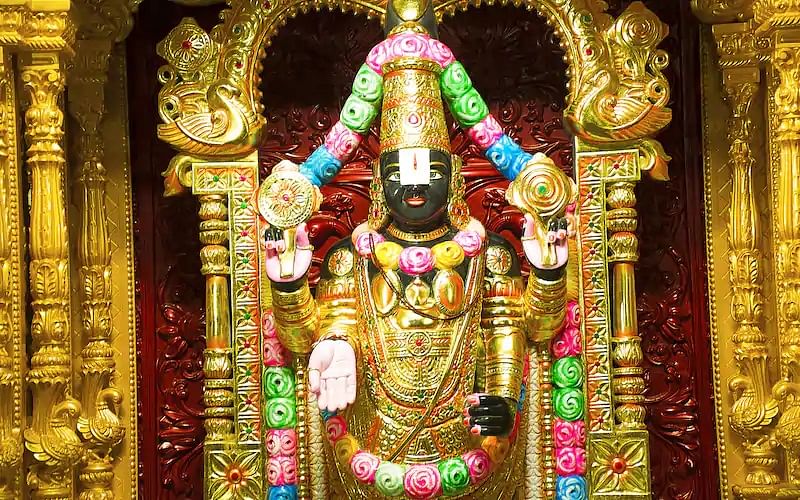Advertisement
Advertisement
The place has the Kaliyuga Vaikuntham name as well, and here the Lord is referred to as Kaliyuga Prathyaksha Daivam. Other names such as Tirumala Temple, Tirupati Temple, Tirupati Balaji Temple also remember the temple. Venkateswara is known by many other names: Balaji, Govinda, and Srinivasa.
In Dravidian architecture, the Temple is constructed and is presumed to be built over a duration of time starting from 300 AD. It is called AnandaNilayam, the Garbagruha (Sanctum Sanctorum). In Garbha gruha, the presiding deity, Venkateswara, is in a standing position and faces east. The temple practices the custom of Vaikhanasa Agama worship. One of the eight Vishnu Swayambhu Kshetras, the temple is identified as the 106th and the last Divya Desam on earth. To coordinate the pilgrim rush, the Temple premises had two new Queue principal components, the Tarigonda Vengamamba Annaprasadam complex for free pilgrim meals, and a variety of pilgrim dwelling sites.
History of Tirupati Balaji Temple :
Venkateswara is depicted by five deities (berams), including the Moolavirat, as per Vaikanasa agamas, who together are referred to as Pancha beramulu (Pancha means five; Beram means deity). Dhruva Beram (Moolavar), Kautuka Beram, Snapana Beram, Utsava Beram and Bali Beram are the five deities. All the pancha berams under Ananda Nilayam Vimanam are put in the Garbha griha. The Hindu scriptures gloriously identify this temple as the earthly place in the age of Kali where Lord Vishnu resides. One of the most important landmarks of Hindu mythology is the Tirupati Balaji or Shree Venkateshwara Swami temple, which occupies a splendid location within the district of Andhra Pradesh. The shrine observes the tradition of worship of "Vaikhanasa Agama," which is believed to be revealed by Sage Vikhanasa and propagated by his followers, Atri, Bhrigu, Marichi, Kasyapa. Vaikhanasa is one of Hinduism's major practices and mainly worships Vishnu as the Supreme God (and his related Avatars). For Vishnu, this ancient text recommends six pujas (worship) times a day, of which at least one puja is compulsory. Rituals are graded as periodic, weekly, and regular. Suprabhata Seva, Thomala Seva, Archana, Kalyanotsavam, Dolotsavam (Unjal Seva), Arjita Brahmotsavam, Arjita Vasantotsavam, Sahasra Dipalankarana Seva, Ekanta Seva are the regular sevas (in order of occurrence) in the Temple. Weekly Temple sevas include Monday's Vishesha Pooja, Tuesday's Ashtadala Pada Padmaradhana, Wednesday's Sahasra Kalasabhishekam, Thursday's Tiruppavada Seva, Friday's Abhishekam and Nijapada Darshanam.
In Dravidian architecture, the Temple is constructed and is presumed to be built over a duration of time starting from 300 AD. It is called AnandaNilayam, the Garbagruha (Sanctum Sanctorum). In Garbha gruha, the presiding deity, Venkateswara, is in a standing position and faces east. The temple practices the custom of Vaikhanasa Agama worship. One of the eight Vishnu Swayambhu Kshetras, the temple is identified as the 106th and the last Divya Desam on earth. To coordinate the pilgrim rush, the Temple premises had two new Queue principal components, the Tarigonda Vengamamba Annaprasadam complex for free pilgrim meals, and a variety of pilgrim dwelling sites.
History of Tirupati Balaji Temple :
Venkateswara is depicted by five deities (berams), including the Moolavirat, as per Vaikanasa agamas, who together are referred to as Pancha beramulu (Pancha means five; Beram means deity). Dhruva Beram (Moolavar), Kautuka Beram, Snapana Beram, Utsava Beram and Bali Beram are the five deities. All the pancha berams under Ananda Nilayam Vimanam are put in the Garbha griha. The Hindu scriptures gloriously identify this temple as the earthly place in the age of Kali where Lord Vishnu resides. One of the most important landmarks of Hindu mythology is the Tirupati Balaji or Shree Venkateshwara Swami temple, which occupies a splendid location within the district of Andhra Pradesh. The shrine observes the tradition of worship of "Vaikhanasa Agama," which is believed to be revealed by Sage Vikhanasa and propagated by his followers, Atri, Bhrigu, Marichi, Kasyapa. Vaikhanasa is one of Hinduism's major practices and mainly worships Vishnu as the Supreme God (and his related Avatars). For Vishnu, this ancient text recommends six pujas (worship) times a day, of which at least one puja is compulsory. Rituals are graded as periodic, weekly, and regular. Suprabhata Seva, Thomala Seva, Archana, Kalyanotsavam, Dolotsavam (Unjal Seva), Arjita Brahmotsavam, Arjita Vasantotsavam, Sahasra Dipalankarana Seva, Ekanta Seva are the regular sevas (in order of occurrence) in the Temple. Weekly Temple sevas include Monday's Vishesha Pooja, Tuesday's Ashtadala Pada Padmaradhana, Wednesday's Sahasra Kalasabhishekam, Thursday's Tiruppavada Seva, Friday's Abhishekam and Nijapada Darshanam.












